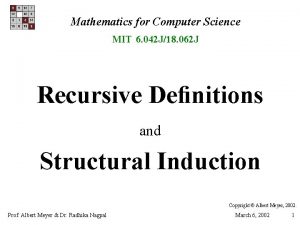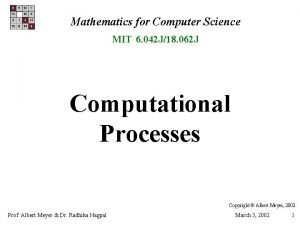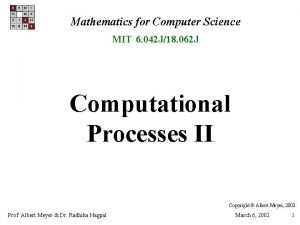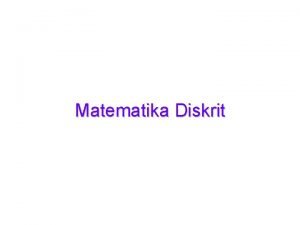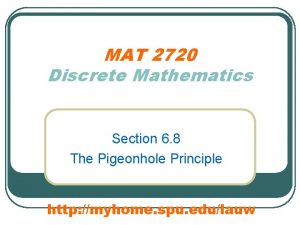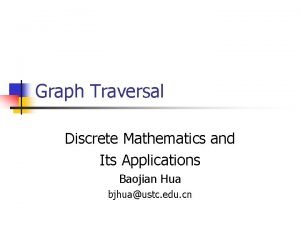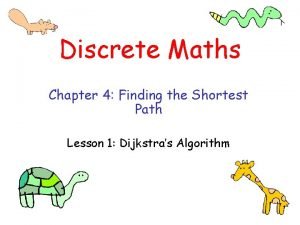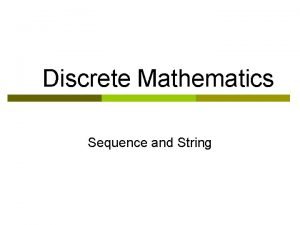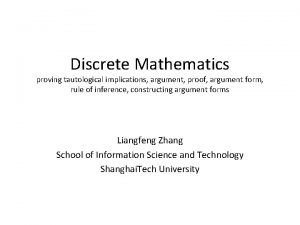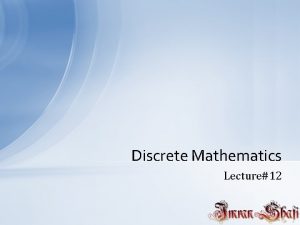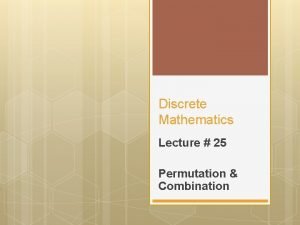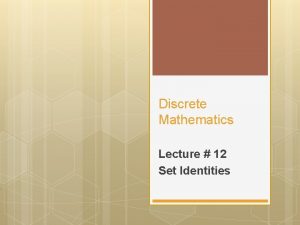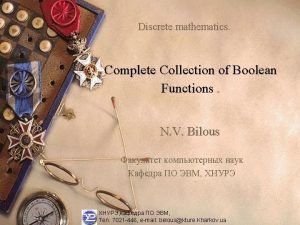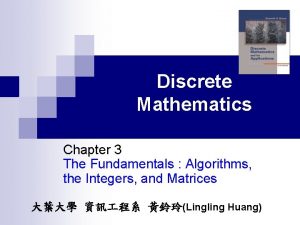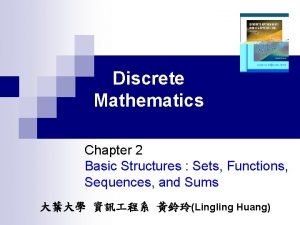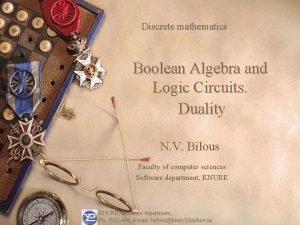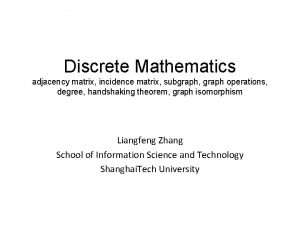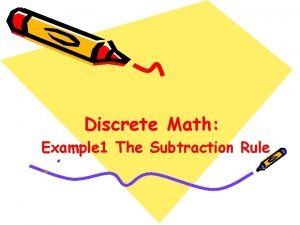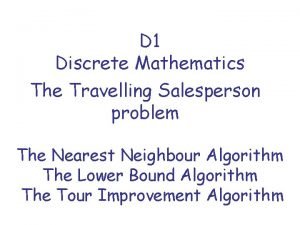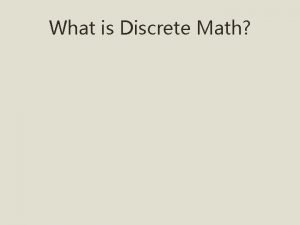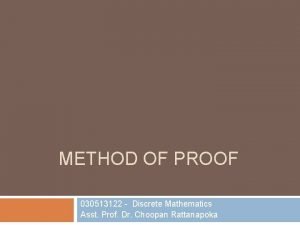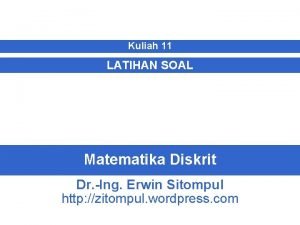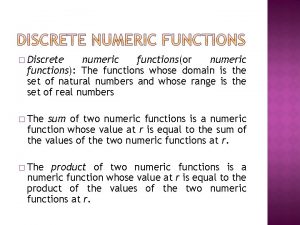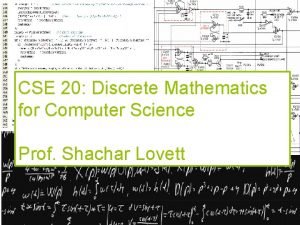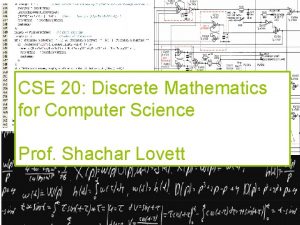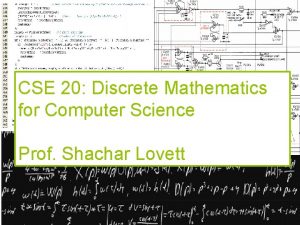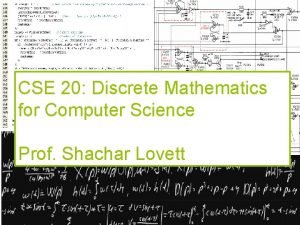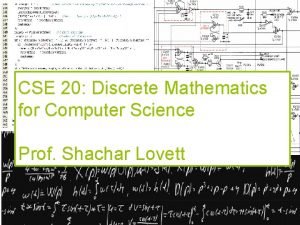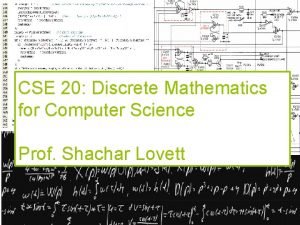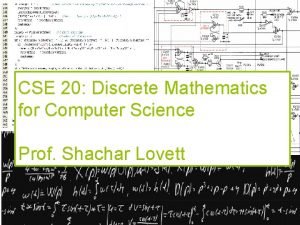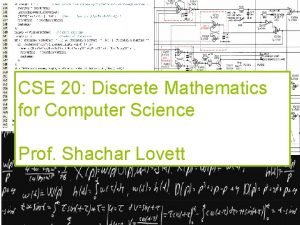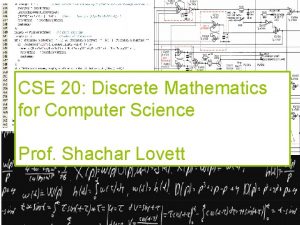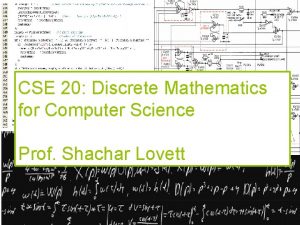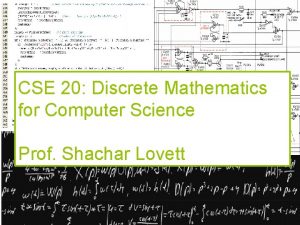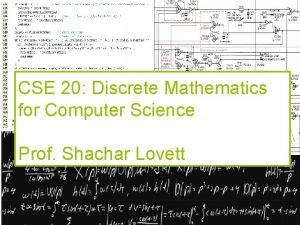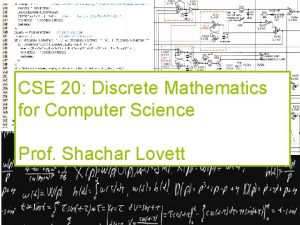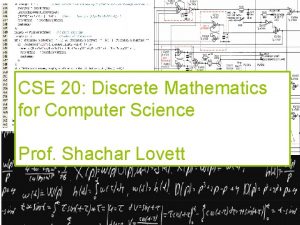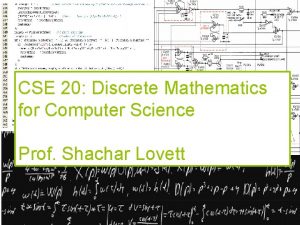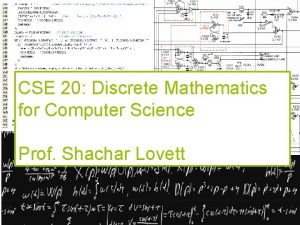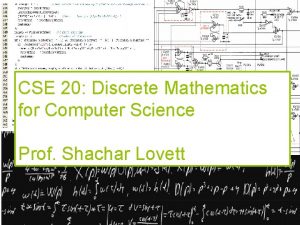CSE 20 Discrete Mathematics for Computer Science Prof



























- Slides: 27

CSE 20: Discrete Mathematics for Computer Science Prof. Shachar Lovett

2 Today’s Topics: 1. Mathematical Induction Proof 3 -cents and 5 -cents example Our first algorithm!

3 1. Mathematical Induction Proof Examples, examples

4 3 -cent and 5 -cent coins We will prove the following theorem Theorem: For all prices p >= 8 cents, the price p can be paid using only 5 -cent and 3 -cent coins 1851 -1889 1866 -today

5 Thm: For all prices p >= 8 cents, the price p can be paid using only 5 cent and 3 -cent coins. Proof (by mathematical induction): Basis step: Show theorem holds for price p=____. Inductive step: Assume [or “Suppose”] that WTS that So the inductive step holds, completing the proof.

6 Thm: For all prices p >= 8 cents, the price p can be paid using only 5 cent and 3 -cent coins. Proof (by mathematical induction): Basis step: Show theorem holds for price p=____. Inductive step: Assume [or “Suppose”] that WTS that A. B. C. D. E. So the inductive step holds, completing the proof. 0 cents 1 cent 2 cents 3 cents Other/none/more than one

7 Thm: For all prices p >= 8 cents, the price p can be paid using only 5 cent and 3 -cent coins. Proof (by mathematical induction): Basis step: Show theorem holds for price p=8. Inductive step: Assume [or “Suppose”] that WTS that So the inductive step holds, completing the proof.

8 Thm: For all prices p >= 8 cents, the price p can be paid using only 5 cent and 3 -cent coins. Proof (by mathematical induction): Basis step: Show theorem holds for price p=8. Inductive step: Assume [or “Suppose”] that WTS that A. B. C. D. E. Theorem is true for p=8. Theorem is true for some p>8. Theorem is true for some p>0. Theorem is true for all p>8. So the inductive step holds, completing the proof.

9 Thm: For all prices p >= 8 cents, the price p can be paid using only 5 cent and 3 -cent coins. Proof (by mathematical induction): Basis step: Show theorem holds for price p=8. Inductive step: Assume [or “Suppose”] that theorem is true for some p 8. WTS that So the inductive step holds, completing the proof.

10 Thm: For all prices p >= 8 cents, the price p can be paid using only 5 cent and 3 -cent coins. Proof (by mathematical induction): Basis step: Show theorem holds for price p=8. Inductive step: Assume [or “Suppose”] that theorem is true for some p 8. WTS that A. B. C. D. Theorem is true for p=8. Theorem is true for some p>8. Theorem is true for p+1. Theorem is true for p+8. So the inductive step holds, completing the proof.

11 Thm: For all prices p >= 8 cents, the price p can be paid using only 5 cent and 3 -cent coins. Proof (by mathematical induction): Basis step: Show theorem holds for price p=8. Inductive step: Assume [or “Suppose”] that theorem is true for some p 8. WTS that theorem is true for price p+1. So the inductive step holds, completing the proof.

12 Thm: For all prices p >= 8 cents, the price p can be paid using only 5 cent and 3 -cent coins. Proof (by mathematical induction): Basis step: Show theorem holds for price p=8. Inductive step: Assume [or “Suppose”] that theorem is true for some p 8. WTS that theorem is true for price p+1. ? ? ? So the inductive step holds, completing the proof.

13 3 -cent and 5 -cent coins Inductive step: Assume price p 8 can be paid using only 3 -cent and 5 -cent coins. Need to prove that price p+1 can be paid using only 3 -cent and 5 -cent coints. Main idea: “reduce” from price p+1 to price p.

14 Making change If we have 100 5 -cent coins, and 100 3 -cent coins (for a total of p = $8. 00), how can we modify the number of 5 -cent and 3 -cent coins so that we can make the p+1 price (p+1 = $8. 01)? A. B. C. 40 5 -cent coins + 200 3 -cent coins 39 5 -cent coins + 202 3 -cent coins 99 5 -cent coins + 102 3 -cent coins

15 Making change If we have 100 5 -cent coins, and 100 3 -cent coins (for a total of p = $8. 00), how can we modify the number of 5 -cent and 3 -cent coins so that we can make the p+1 price (p+1 = $8. 01)? A. B. C. 40 5 -cent coins + 200 3 -cent coins 39 5 -cent coins + 202 3 -cent coins 99 5 -cent coins + 102 3 -cent coins

16 Turning our modification scheme into a generic algorithm If we have n 5 -cent coins, and m 3 -cent coins (for a total of p = 5 n+3 m), how can we modify the number of 5 -cent and 3 -cent coins so that we can make the p+1 price (p+1 = 5 n+3 m+1)? A. B. C. D. n+1 5 -cent coins + m-2 3 -cent coins n-1 5 -cent coins + m+2 3 -cent coins n+1 5 -cent coins + m+2 3 -cent coins No generic way

17 Turning our modification scheme into a generic algorithm If we have n 5 -cent coins, and m 3 -cent coins (for a total of p = 5 n+3 m), how can we modify the number of 5 -cent and 3 -cent coins so that we can make the p+1 price (p+1 = 5 n+3 m+1)? A. B. C. D. n+1 5 -cent coins + m-2 3 -cent coins n-1 5 -cent coins + m+2 3 -cent coins n+1 5 -cent coins + m+2 3 -cent coins No generic way

18 What if we don’t have any 5 -cent coins to subtract? ? If we have 0 5 -cent coins, and m 3 -cent coins (for a total of p = 3 m), how can we modify the number of 5 -cent and 3 -cent coins so that we can make the p+1 price (p+1 = 3 m+1)? A. B. You can’t You can [explain to your group how]

19 What if we don’t have any 5 -cent coins to subtract? ? If we have 0 5 -cent coins, and m 3 -cent coins (for a total of p = 3 m), how can we modify the number of 5 -cent and 3 -cent coins so that we can make the p+1 price (p+1 = 3 m+1)? Remove So: three 3 -cent coins, add two 5 -cent coins, m-3 3 -cent points, for a total of 2*5+3*(m-3)=3 m+1=p+1

20 That algorithm relies on being able to subtract three 3 -cent coins. What if we don’t have that many? (only 1 or 2? ) A. B. C. Uh-oh, our proof can not work as we’ve done it so far That could never happen [explain why not] That could happen, and we need to make a 3 rd (or more) case(s) to handle it

21 Thm: For all prices p >= 8 cents, the price p can be paid using only 5 cent and 3 -cent coins. Proof (by mathematical induction): Basis step: Show theorem holds for p=8 (by example, e. g. p=3+5) Inductive step: Assume [or “Suppose”] that theorem holds for some p 8. WTS that theorem holds for p+1. p 8. Assume that p=5 n+3 m where n, m 0 are integers. We need to show that p+1=5 a+3 b for integers a, b 0. Partition to cases: Case I: n 1. In this case, p+1=5*(n-1)+3*(m+2). Case II: m 3. In this case, p+1=5*(n+2)+3*(m-3). Case III: n=0 and m 2. Then p=5 n+3 m 6 which is a contradiction to p 8. So the inductive step holds, completing the proof.

22 We created an algorithm! Our proof actually allows us to algorithmically find a way to pay p using 3 -cent and 5 -cent coins Algorithm start for price p: with x=8=3+5 For x=8. . . p, in each step adjust the number of coins according to the modification rules we’ve constructed to maintain price x

23 Algorithm pseudo-code Pay. With. Three. Cents. And. Five. Cents: Input: price p 8. Output: integers n, m 0 so that p=5 n+3 m 1. 2. Let x=8, n=1, m=1 (so that x=5 n+3 m). While x<p: a) b) c) 3. x: =x+1 If n 1, set n: =n-1, m: =m+2 Otherwise, set n: =n+2, m: =m-3 Return (n, m)

24 Algorithm pseudo-code Pay. With. Three. Cents. And. Five. Cents: Input: price p 8. Output: integers n, m 0 so that p=5 n+3 m 1. Let x=8, n=1, m=1 (so that x=5 n+3 m). 2. While x<p: a) b) c) 3. x: =x+1 If n 1, set n: =n-1, m: =m+2 Otherwise, set n: =n+2, m: =m-3 Return (n, m) Invariant: x=5 n+3 m We proved that n, m 0 in this process always; this is not immediate from the algorithm code

25 Algorithm run example x=8: n=1, m=1 While x<p: Invariant: x=5 n+3 m a) x: =x+1 b) If n 1, set n: =n-1, m: =m+2 c) Otherwise, set n: =n+2, m: =m-3 8= 9= 10 = 11= 12 =

26 Algorithm properties Theorem: Algorithm uses at most two nickels (i. e n 2) Proof: by induction on p Try to prove it yourself first! x=8: n=1, m=1 While x<p: Invariant: x=5 n+3 m a) x: =x+1 b) If n 1, set n: =n-1, m: =m+2 c) Otherwise, set n: =n+2, m: =m-3

27 x=8: n=1, m=1 While x<p: Invariant: x=5 n+3 m a) x: =x+1 b) If n 1, set n: =n-1, m: =m+2 c) Otherwise, set n: =n+2, m: =m-3 Algorithm properties Theorem: Algorithm uses at most two nickels (i. e n 2). Proof: by induction on p Base case: p=8. Algorithm outputs n=m=1. Inductive hypothesis: p=5 n+3 m where n 2. WTS p+1=5 a+3 b where a 2. Proof by cases: Case I: n 1. So p+1=5(n-1)+3(m+2) and a=n-1 2. Case II: n=0. So p+1=5*2+3(m-3). a=2. In both cases p+1=5 a+3 b where a 2. QED
 Mathematics for computer science mit
Mathematics for computer science mit Die hard
Die hard Mathematics for computer science mit
Mathematics for computer science mit Rosen textbook
Rosen textbook Pigeonhole principle in discrete mathematics
Pigeonhole principle in discrete mathematics What is tautology in math
What is tautology in math Logical form and logical equivalence
Logical form and logical equivalence Dfs in discrete mathematics
Dfs in discrete mathematics Dijkstra's algorithm in discrete mathematics
Dijkstra's algorithm in discrete mathematics Sequence discrete math
Sequence discrete math What is tautology in math
What is tautology in math Symmetric relation definition
Symmetric relation definition Application of propositional logic
Application of propositional logic Permutation and combination in discrete mathematics
Permutation and combination in discrete mathematics Set identities discrete math
Set identities discrete math Boolean function in discrete mathematics
Boolean function in discrete mathematics Discrete probability and advanced counting techniques
Discrete probability and advanced counting techniques Discrete mathematics chapter 3 solutions
Discrete mathematics chapter 3 solutions Sets and functions in discrete mathematics
Sets and functions in discrete mathematics Demorgan's law proof
Demorgan's law proof Duality in discrete mathematics
Duality in discrete mathematics Incidence matrix in discrete mathematics
Incidence matrix in discrete mathematics Product rule discrete math
Product rule discrete math Travelling salesman problem in discrete mathematics
Travelling salesman problem in discrete mathematics What is discrete mathematics
What is discrete mathematics Pqqpq
Pqqpq Soal matematika kuliah semester 6
Soal matematika kuliah semester 6 The domain of discrete numeric function is
The domain of discrete numeric function is
